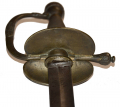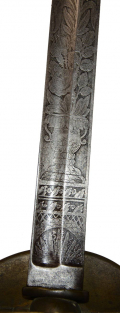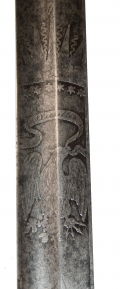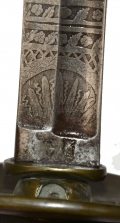site search
online catalog
MEXICAN WAR INSCRIBED U.S. MODEL 1840 FOOT OFFICER’S SWORD

$2,250.00
Quantity Available: 1
Item Code: 160-182
Shipping: Determined by Method & Location of buyer
To Order:
Call 717-334-0347,
Fax 717-334-5016, or E-mail
Introduced into the army in 1841, these swords follow the general lines of the 1834 pattern in using a “cut-and-thrust” blade with a double-clamshell guard, but employ a spearpoint blade with single edge and wide fuller more appropriate for the thrust than the cut, and are carried by “officers of infantry serving on foot” in a simple black leather scabbard fitted with a boot-shaped drag and a long brass throat fitted only with a moulded frog hook since the sword was to be carried on a shoulder belt. The gilt brass hilt retains the 1834 type grip imitating silver wire binding (embossed sheet silver by Ames and plated brass by the imports,) but what had been a boat-shaped counterguard is flattened out and the two lobes given rounded edges, with the reverse side able to be folded down for greater comfort when worn against the side. The underside of the guard is also fitted with a small, flat oval plate on the blade mound to act as a stop for the scabbard throat. As Thillmann notes, the hilt is a combination of Prussian, French and British styles, with the Ames made versions using a lower, urn shaped pommel and plain tip to the quillon, where the imports (by Schnitzler and Kirschbaum or Gebruder Weyersberg) use a tall, lantern shape pommel and decorated quillon tip in imitation of British patterns.
These swords were the regulation U.S. officer’s sidearm in the Mexican War, though some officers replaced them with sabers for wear in the field, and they remained regulation until the introduction of the 1851 pattern officers’ swords. This is most likely a Horstmann import or assembled sword. The cast floral work at the juncture of the knucklebow and pommel point to an import, as does the decoration of the quillon tip and the blade bears a deep kings-head Weyersberg blade maker’s mark. The blade etching is Weyersberg as well, though the pommel is more urn shaped, in imitation of the Ames style. The sword is completely original, full length, with a full-length 32-inch blade with good edge and tip, and scabbard, which is similar to a M1840 NCO scabbard, but uses a flat top to the throat, rather than a raw edge, and a drag blade with a scalloped edge having pronounced points rather than simple notches, a higher quality appropriate for an officer’s scabbard. The finish is good, showing minor rubs and just one spot where some blacking was applied to cover a rub. The hilt and mounts have an aged brass patina. The grip, as typical of import versions, shows as a darkly tarnished silver wash with dark brass showing underneath. The quillon is bent slightly back and the spring button supporting the folding counterguard is missing. The scabbard has shrunk slightly with age so the sword is tight when sheathed.
The blade is etched on both sides, with the frosting oxidized to gray, but the motifs both fully visible and legible. The obverse blade is decorated with a starburst with lightning bolts at bottom, a narrow latticework, urn, dense leaf and petal foliage sprouting upwards to a U.S. eagle clutching arrows and olive branch in its talons and an E PLURIBUS UNUM inscribed banner scroll in its beak that is flourished overhead, with an arc of stars and sunburst rays with lightning bolts, as at base of blade, overhead, followed by a branch of oak leaves and acorns. The reverse uses a similar sequence of motifs, but substitutes a horizontal “U.S.” for the American eagle as the central panel.
The reverse counterguard is engraved with the three interlocking chain links associated with the Independent Order of Odd Fellows, a fraternal group organized in the U.S. in Baltimore in 1819. The obverse counterguard is engraved in script: “Lieut. John W. McDowell USA.” The abbreviation “USA” should mean US Army and we find just one candidate in Heitmann, a 2nd Lt. John McDowell, who served in the New Jersey Battalion, which consisted of four companies, who served in Mexico from September 1847 to August 1848, mostly on garrison and escort duty around Vera Cruz. We would expect a state designation rather than “US Army,” but since the battalion was created under a call from President Polk through the Secretary of War for the Governor to supply the troops, the designation might be permissible, even if they were not regulars. A greater problem is that the index of Mexican War service records gives his middle initial as “L.” This is possible error of transcription in handwritten records that some further research might straighten out. A Lt. John B. McDowell shows up in the 4th Illinois, but that seems a less likely mistake. The only unambiguous John W. McDowell we find was only a private and corporal in the 3rd Ohio. Two further clues might lead to something: a connection to the Odd Fellows and the one bit of provenance we have that the sword turned up in a Kentucky estate. In any case, the sword is a very good example of a U.S. regulation officer’s sword from the Mexican War. [sr] [ph:L]
~~~~~~~~~~~~~~~~~~~~~~~~~~~~~~~~~~~
THIS ITEM, AS WITH ALL OTHER ITEMS AVAILABLE ON OUR WEB SITE,
MAY BE PURCHASED THROUGH OUR LAYAWAY PROGRAM.
CLICK HERE FOR OUR POLICIES AND TERMS.
THANK YOU!
Inquire About MEXICAN WAR INSCRIBED U.S. MODEL 1840 FOOT OFFICER’S SWORD
For inquiries, please email us at [email protected]
Most Popular
Historical Firearms Stolen From The National Civil War Museum In Harrisburg, Pa »
Theft From Gravesite Of Gen. John Reynolds »
Cavalry Carbine Sling Swivel »
Fine Condition Brass Infantry Bugle Insignia »
featured item
NON-REGULATION SILVER GRIPPED PRESENTATION SWORD BY SCHUYLER, HARTLEY & GRAHAM - LT. JAMES MOFFAT, 16TH NEW YORK CAVALRY
This presentation sword has very impressive deeply cast and chased mounts and silver gripped hilt. Schuyler, Hartley and Graham assembled and sold a wide variety of swords that were often highly embellished and upgraded from regulation patterns, to… (870-653). Learn More »

























